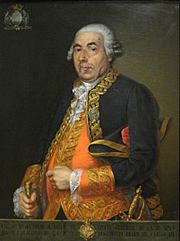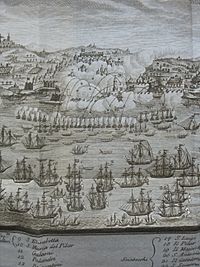Bombardment of Algiers (1783) facts for kids
Quick facts for kids Bombardment of Algiers (1783) |
|||||||
|---|---|---|---|---|---|---|---|
| Part of the Spanish-Algerian war (1775-1785) | |||||||
 Map of Algiers' Bombardment of 1783 by Antonio Barceló. |
|||||||
|
|||||||
| Belligerents | |||||||
| Commanders and leaders | |||||||
| Strength | |||||||
| 4 ships of line, 4 frigates, 68 other ships | 2 demi-galleys, 2 xebecs, 6 gunboats, 1 felucca | ||||||
| Casualties and losses | |||||||
| 26 dead 1500 lb gunpowder stolen |
1 gunboat 562 buildings destroyed or damaged |
||||||
The Bombardment of Algiers in August 1783 was when Spain tried to stop Algerian ships from attacking Spanish trade ships. A large Spanish fleet, led by Rear Admiral Antonio Barceló, attacked the city of Algiers. They fired on the city eight times between August 4 and 8. However, the attack caused only minor damage to the Algerian military.
Both sides did not fight very well. Admiral Barceló said bad weather was the reason for their problems. He then ordered his ships to leave. The Spanish court saw this mission as a failure. One person even called it a "festival of fireworks too costly and long for how little it entertained the Moors and how it was used by whomever paid for it".
Contents
Why the Bombardment Happened
In 1775, Spain had already tried to attack Algiers. A Spanish fleet of 51 ships carried 20,000 soldiers to fight the Barbary pirates. These pirates often attacked ships in the Mediterranean Sea. The Spanish suffered many losses, with over 2,500 soldiers killed or wounded. The Algerians also lost about 5,000 people.
After this failed attack in 1775, Algerian pirate attacks on Spanish ships actually increased. Spain then tried to make a peace deal with the Ottoman Regency, which ruled Algiers. This was to protect their trade ships.
In 1782, a Spanish diplomat named Don Juan de Bouligny went to Constantinople (now Istanbul). He managed to get a friendship and trade agreement with Sultan Abdul Hamid I. But the rulers of Algiers refused to accept this treaty.
The Dey (the ruler of Algiers) decided to go to war. He listened to some of his officers, even though his naval officers advised against it. Spain's chief minister, the Count of Floridablanca, then tried to bribe the Dey with gold to start peace talks. But this also failed.
King Charles III of Spain felt that Spain's pride had been hurt by the Algerians. So, he decided to punish them by bombing their city. Rear Admiral Antonio Barceló was chosen to lead this attack. Barceló was a very skilled naval officer. He had earned his rank through hard work, not because of his family. But many senior Spanish officers were jealous of him. This was because he was older, could not read or write, and came from a humble background.
The Attack on Algiers
Barceló's fleet left Cartagena, Spain, on July 2. It included 4 large warships, 4 smaller frigates, and 68 smaller boats. These smaller boats included gunboats and bomb vessels, which were ships designed to fire bombs.
The Algerians had a much smaller fleet. They had only 2 demi-galleons (small galleys) with 5 guns each, a felucca (a small boat) with 6 guns, two xebecs (sailing ships) with 4 guns each, and 6 gunboats. Their gunboats carried 12 and 24-pounder cannons.
On July 29, the Spanish fleet arrived near Algiers. Two days later, Barceló prepared his ships for the attack. The bomb-ketches and gunboats went first, supported by other small vessels. The larger warships and frigates protected them.
The bombing started at 2:30 PM and continued until sunset. The attack was repeated every day until August 9. On that day, the Spanish leaders decided to return to Spain.
During these attacks, the Spanish fired 3,732 mortar shells and 3,833 cannon shots. The Algerians fired back with 399 mortar shells and 11,284 cannon shots. Even with all this firing, neither side caused much damage. The city of Algiers caught fire several times, but the fires were quickly put out.
The Algerians used "red-hot balls," which were cannonballs heated until they glowed. These were used in the Great Siege of Gibraltar to great effect. However, they did not work as well in Algiers. The Algerians also made some brave attacks with their small boats. But the Spanish fleet's stronger firepower always pushed them back.
The Dey of Algiers hid in his fortress during the battle. The city's defense was mostly handled by a group of local fighters, many of whom were teenagers. Twenty-five heavy cannons that Algiers had bought from Denmark exploded during the battle. This happened because they were either used incorrectly or were in bad condition.
The bombardment destroyed or damaged 562 buildings. This was not a huge number, considering Algiers had about 5,000 buildings. The whole city was open to Spanish fire. The Algerians lost only one gunboat. The Spanish also had very few losses: 26 killed and 14 wounded.
What Happened Next
The Spanish government officially said they left because of bad weather. But this excuse was not very believable. The weather in the Mediterranean Sea is usually good for sailing in the summer.
To make the bombing seem like a success, many participants were promoted in rank. Many poems were written celebrating the Spanish "victory." These poems were often exaggerated. But in reality, Spain had not achieved anything.
Two months later, five Algerian pirate ships captured two Spanish merchant vessels near Palamós. This was a clear sign that they were not afraid. Because of this, Spain had to prepare a new, much bigger expedition to attack Algiers again the next year. This led to the Bombardment of Algiers (1784).
Images for kids
See also
 In Spanish: Bombardeo de Argel (1783) para niños
In Spanish: Bombardeo de Argel (1783) para niños






